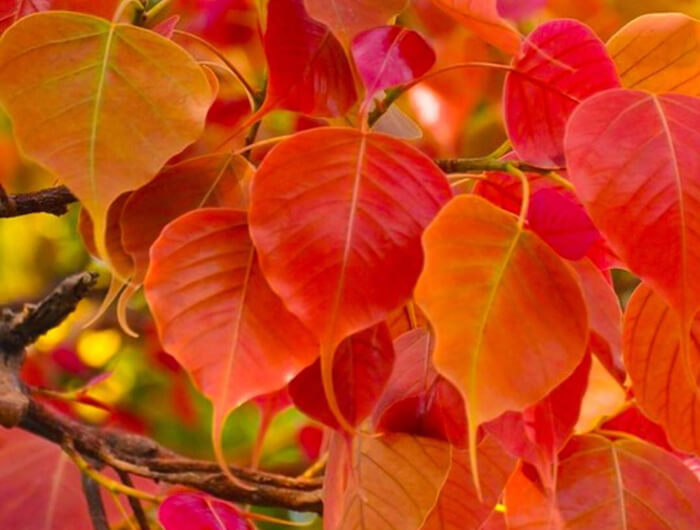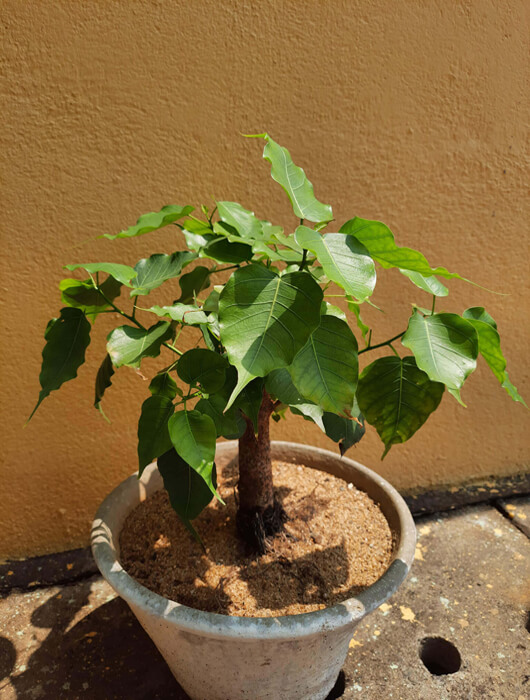Peepal Tree – Significance and Importance

Peepal Tree ( Ficus religiosa ) is considered a sacred tree in Hinduism. The Peepal tree is revered by both Jains and Buddhists. Ayurveda uses its stem bark, fruits, root, leaf, milk, and tender shoots, for medicinal uses.
Krishna says in the Bhagavad Gita, “I am the Peepal tree (ashvattha) among the trees.” As a result, many people believe it to be Lord Vishnu. It is believed to be a holy deity representing the three supreme Gods- Vishnu, Shiva, and Brahma. The sources are Brahma, Vishnu is the trunk and, Shiva the leaves. The Peepal tree is also mentioned in the Upanishads. For Buddhists, the significance of the peepal tree lies in the fact that Gautama Buddha got enlightenment under a peepal tree at Bodhgaya.
According to Shastras, worshipping a peepal tree brings all devi-devtas’ blessings. Even though all days are good for worship, doing so on Sunday brings poverty into the home.
Morphology of Peepal tree
The Peepal tree is large, growing to a height of 20-25 meters and 2-3 meters in diameter, and is found all over India. The bark of the tree is pale brownish white, cracked in nature. Its leaves are thin, shining cardiac-shaped at the base and elongated at the tip, and have 5-7 visible veins. The fruit of the peepal tree is small, round, about 0.5 inch in diameter. They are green when unripe and turn to a blackish color when ripe. Fruits can be found during summer and are ripe during the rainy season. People belonging to Hindu and Buddhist religions consider the tree to be sacred and they can easily be found planted around temples.
History of Peepal Tree
Peepal trees were first cultivated in Mohenjodaro city during the Indus Valley Civilization (3000 BC – 1700 BC). Excavations show that the Peepal tree was revered by Hindus even at that time. A seal was found at Mohenjo-Daro, one of the cities of the IVC, which shows the people worshipping the Peepal tree.
The wood obtained by cutting the Peepal tree was used to make a fire during the Vedic period. It is known as “Ashvattha” in Sanskrit and is a large tree and India’s first depicted tree. The tree enjoys great eminence since the early days of Indian society. Therefore, no wonder it is nothing but the king of all trees.
Benefits
Considered the ‘Tree of Life’, the peepal tree has been used in Ayurveda since ancient times. Also known as Bodhi Satva, it has a lot of benefits and medicinal properties and is used in mainstream and Ayurvedic medicine quite commonly.
It has many medicinal and environmental benefits. Ecologically, Peepal Tree provides ample Oxygen, purifies the surrounding, kills harmful bacteria, control soil erosion, and improve soil structure and fertility, it is also dust and sound-absorbent. It is believed that the Peepal tree releases Oxygen during the night also due to a special photosynthesis process called Crassulacean Acid Metabolism (CAM). This tree is also thought to have a lot of medicinal properties. Its leaves, wood, roots, and bark are used to treat a variety of ailments. Ayurvedic studies are also dominated by the sections of this herb.
Uses of Peepal Tree

The peepal tree benefits start with its immense medicinal qualities which scientists still discover even today. These qualities are used extensively in the field of Ayurveda.
Peepal Leaves

One can extract the juice of its leaves when you hold these near the fire. One can also use it as an eardrop. Also, the leaves of the peepal are useful to treat constipation. Its leaves are also fed to camels and elephants or are useful for decoration purposes.
Peepal Bark
A powder made from its bark heals wounds of yesteryears. Meanwhile, the bark itself is useful in treating inflammation and glandular swelling of the neck. Peepal bark helps in yielding a reddish dye.
Roots of Peepal Tree
Peepal tree benefits lie in its roots as well. Its root is useful for stomatitis, cures ulcers, and promotes granulation. Its roots are also good for gout. People even chew the roots to prevent gum diseases.
Fruit
Its fruit also offers a host of benefits, such as it works as a laxativea. It also aids in digestion. Fruits keep a check on vomiting and are good for foul taste and thirst and heart diseases. It is often taken in powdered form and is beneficial for asthma.







